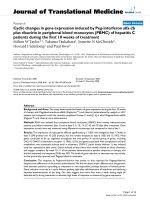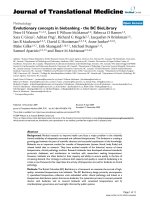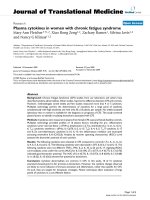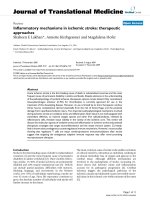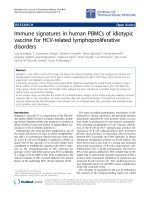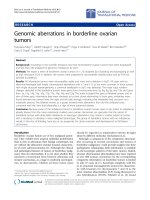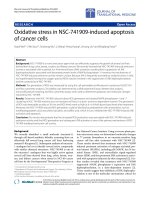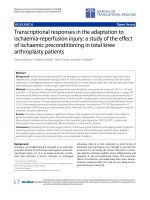Báo cáo hóa học: "Vehicular connectivity in urban scenarios: effectiveness and potential of roadside, moving WAVE providers and hybrid solutions" doc
Bạn đang xem bản rút gọn của tài liệu. Xem và tải ngay bản đầy đủ của tài liệu tại đây (1.21 MB, 10 trang )
RESEARCH Open Access
Vehicular connectivity in urban scenarios:
effectiveness and potential of roadside, moving
WAVE providers and hybrid solutions
Claudia Campolo
1*
, Hector Agustin Cozzetti
2
, Antonella Molinaro
1
and Riccardo Scopigno
2
Abstract
Vehicular ad-hoc networks are expected to be a key enabling technology for the development of future Intelligent
Transportation Systems (ITSs), by delivering a wide range of services, spanning from safety alerting to route
guidance and entertainment. Most of ITS applications require vehicles on the road to access the Internet through
wireless communications with road-side units. The high vehicle mobility coupled with the large amount of
investments required for deploying a complete roadside infrastructure will cause vehicle-to-roadside (V2R)
connectivity to be poor, short-lived, and intermittent by negatively affecting the performance of envisioned
applications. The purpose of this paper is to gain a deeper insight into possible issues related to service acce ss and
provisioning when considering the multi-channel operations envisioned by the IEEE 802.11p/WAVE (Wireless Access
in Vehicular Environments) standards. We investigate network connectivity offered by roadside and moving WAVE
providers in a realistic urban scenario where wirel ess propagation is hindered by obstructions. Results prove that
hybrid solutions complementing roadside providers with moving ones lead to improved connectivity and data
delivery performance, by potentially incurring lower deployment costs.
Introduction
Several ongoing research efforts supported by car and
electronic industries, governments and academia are
underway to foster the deployment of Vehicular Ad-Hoc
NETworks (VANETs). VANETs are expected to be a
key enabling technology for the development of Intelli-
gent Transportation Systems (ITSs) meant to improve
the quality of transportation by enabling a broad range
of applications: primarily safety but also services aimed
at traffic management, enhanced drive comfort, audio/
video streaming and generalized information and
entertainment.
Vehicles may need to exchange with remote ITS ser-
vers a wide range of heterogeneous information ranging
from environmental data (e.g., pollution measurements,
average vehicle density and speed) to informative con-
tents (e.g., e-maps, news items, proximity advertise-
ments, etc).
To this purpose, roadside units (RSUs), located along
the road or in points-of-interest, are needed to provide
Internet access to on board units (OBUs) in vehicles.
However, especially in the early deployment stages of
VANETs, the coverage of RSUs will not be complete
due to the high costs for planning, deploying, and main-
taining an ubiquitous roadside infrastructure.
Poor, short-lived, and intermittent connectivity will be
prov ided to users on vehicl es by negatively affecting the
overall performance of vehicular applications. Therefore,
further connectivity solutions need to be explored: spe-
cial vehicles (e.g., police cars, highway assistance or fire-
fighting vehicl es, public transportation means like buses
or trams) and private cars could share their Internet
access and act as gateways toward the Internet.
The purpose of this paper is to gain a deeper insight
into the topic of vehicular co nnectivity in challenging
urban scenarios by considering the features of the
multi-channel architecture envisioned by the IEEE
802.11p [1] standard, recently ratified as an amendment
of the IEEE 802.11 to provide Wireless Access in Vehi-
cular Environments (WAVE) [2]. A single common con-
trol channel (CCH) is used for safety messages and
* Correspondence:
1
DIMET-Dipartimento di Informatica, Matematica, Elettronica e Trasporti,
Università Mediterranea di Reggio Calabria, Reggio Calabria, Italy
Full list of author information is available at the end of the article
Campolo et al. EURASIP Journal on Wireless Communications and Networking 2011, 2011:146
/>© 2011 Campolo et al; licensee Springer. The paper is an extended version of the paper “Roadside and Moving WAVE Providers:
Effectiv eness and Potential of Hybri d Solutions in Urban Scenarios” presented at the 11th International Conference on
Telecommunications for Intelligent Transport Systems (ITST 2011). This is an Open Access article distributed under the terms of the
Creative Commons Attribution License ( which permits unrestricted use, distribu tion, and
reproduction in any medium, pro vided the original work is properly cite d.
control frames delivery, while multiple service channels
(SCHs) are for non-safety applications.
According to WAVE specifications, nodes offering
connectivity serv ices and the prov isioning of non-safety
applications over SCHs can be both RSUs and OBUs
and they are called providers.
Connectivity offered by WAVE providers can heavily
change depending on network and environmental condi-
tions. Indeed, it is e xpected to be affected by positions
of providers and their mobility patterns (in case of
OBUs), street layouts, road congestion, fading and other
propagation effects like diffractions, reflections and
obstructions which are the aspects which mostly differ-
entiate urban from other road settings.
Despite very complex, these phenomena have been
recently demonstrated to be effectively simulated by
simple (and not simplistic) models [3-5]. While the sug-
gested models are str aightforward, they adhere to and
are validated by existing measurements [4,6] a nd, what
makes them relevan t, can deeply influence and change
the results.
This paper exploits some recent modeling achieve-
ments [3] to study the novel topic of WA VE connect iv-
ity offered by roadside and moving nodes in a urban
setting. The model in [3] accounts for urban obstruc-
tions and has been integrated into the widely used ne t-
work simulator NS-2 [7]. There it has been justified by
measurements from literature and here is validated by
means of ray-tracing software, confirming the reliability
and accuracy of the additi onal attenuation values
selected for urban simulations.
The main contributions of the paper can be summar-
ized as follows:
• the investigation of connectivity performance in
the realistically modeled urban scenario by consider-
ing different settings: RSUs differently placed on the
road, OBUs providers, and hybrid solutions lever-
aging the coexistence of roadside and moving WAVE
providers and by ac counting for the specifica tions of
the IEEE 802.11p/WAVE multi-channel architecture;
• the performance evaluation of data delivery (e.g.,
ITS-related content) on service channels when only
RSUs act as providers and when hybrid connectivity
solutions are considered.
The rest of the paper is organized as follows. Section 2
describes the main features of IEEE 802.11p and WAVE;
in Section 3, the obstruction model is presented and
further validated by a ray-tracing software; simulation
settings and results are respectively presented and dis-
cussed in Sections 4 and 5; conclusions are finally
drawn in Section 6.
WAVE protocol suite
The IEEE 802.11p task group [1] ha s specified enhance-
ments to the 802.11 physical (PHY) and medium access
control (MAC) layers to address communications in
vehicular environments.
The PHY layer is an amendment of 80 2.11a, and it is
based on Orthogonal Frequency-Division Mul tiplexing
(OFDM). Compared with IEEE 802.11a, the main differ-
ences concern time-parameters which get doubled in
802.11p to cope with the harsh vehicular environment:
this is aimed at counteracting simultaneously inter-car-
rier interferences due to Doppler spread and inter-sym-
bol interferences due to fading. As a result, halved data
rate values are available in 802.11p ranging from 3 to 27
Mbps.
Seven 10 MHz-wide channels are available in the fre-
quency band of 5.85-5.925 GHz allocated for the Dedi-
cated Short Range Communication (DSRC)-based ITS
services in US.
The European Telecommunications Standard Institute
(ETSI) has also allocated a similar radio spectrum of 50
MHz. In both spectrum, one of the channels is reserved
as a control channel for the exchange of system control
and time-sensitive safety messages, while the rest (up to
six in US and up to four in Europe) are service channels
available to exchange not c ritical non-safety data pack-
ets, e.g. infotainment and ITS-related contents.
The IEEE 802.11p MAC layer exploits the Enhanced
Distributed Channel Access (EDCA) scheme, which pro-
vides differentiated and distributed channel access.
IEEE 802.11p cooperates with the IEEE 1609 family
[2], covering higher protocol layers, to define a standard
protocol stack for vehicular environments.
Among the IEEE 1609 documents, the IEEE 1609.4 [8]
enhances the 802.11p MAC laye r to work in a multi-
channel environment. WAVE devices are expected to be
deployed either as single-radio devices, which operate
on one radio channel at a time or as dual-radio devices,
which are capable of simultaneously monitoring control
and service channels.
In a WAVE environment, both kinds of devices must
have the possibility to tune in the same channel at t he
same time so that they can communicate. Therefore,
above the IEEE 802.11p MAC layer, the 1609.4 specifi-
cations define four channel access switching modes: con-
tinuous, alt ernatin g, im mediate,andextended access,
Figure 1. According to the continuous access scheme, a
node always stays tuned to the CCH to exchange safety-
related data.
A node working in the alternating access scheme
switches between the CCH and the available SCHs at
scheduled time intervals. Specifically, the channel time
is divided into synchronization intervals with a fixed
Campolo et al. EURASIP Journal on Wireless Communications and Networking 2011, 2011:146
/>Page 2 of 10
length of 100 ms, consisting of 50 ms-long CCH and
SCH interval. Single-radio devices have to monitor the
CCH during common time intervals (the CCH inter-
vals), and to (optionally) switch t o one SCH during the
SCH intervals. D ual-radio devices can tune one radio
into CCH, while a second radio could be tuned in to one
of the SCHs. The described operation allows the safety
warning messages to be transmitted on CCH, while
non-safety data applications may simultaneously run
over SCHs.
The immediate access allows immediate communica-
tions over t he SCH without waiting for the next SCH
interval, by avoiding the latency of the residual CCH
interval. The extended access allows communications
over the SCH without pauses for CCH access and is
useful for services which require a huge amount of data
to be transfer red and take several periods to be
delivered.
The latter two schemes can be only beneficial to those
vehicles which are not interested in cooperative safety
applications; therefore, proper use cases need to be
investigated for them.
At the early deployment stages of VANETs WAVE
devices are expected to be low cost single-radio devices
mainly enforcing the alternating switching scheme.
Coordination between channels exploits a global time
reference, such as the Coordinated Universal Time
(UTC), which can be supposed to be provided by the
Global Positioning System (GPS).
Nodes aiming to initialize a Basic Service Set (BSS)
among vehicles to exchange non-safety data over SCHs
are called providers. Each provider announces itself and
the set-up of its BSS by periodical WAVE Service Adver-
tisement (WSA) messages broadcasted to nearby, 1-hop-
far nodes, during the CCH interval. WSAs contain the
information about the offered services and the network
parameters necessary to join the advertised BSS (its iden-
tification, its SCH, its EDCA parameter sets, configura-
tion parameters needed to access the Internet, etc.).
Providers broadcast WSAs without any feedback on
their successful reception; thus, the standard suggests
that each provider sends more WSAs in the CCH inter-
val for reliability purposes.
Providers should choose the least congested SCH for
their BSS set up in order to reduce interference between
nearby BSSs. However, how this is to be done is not
specified in the standard specifications.
Nodes looking for avail able services, namely WAVE
users, should monitor the CCH listening for WSAs to
learn about the existence and the operationa l para-
meters of available BSSs. If they receive at least a WSA
frame from a nearby provider, i n order to join the BSS
during the subsequent service channel interval they sim-
ply switch on the SCH frequency advertised in the WSA
and start to exchange data with the provider.
Urban scenario and its criticalities
Nowadays, network simulators, like NS-2 [7], have sped
up the analysis of various network scenarios, under sev-
eral settings. These tools enable a pretty precise under-
standing of protocol mechanisms but, under certain
circumstances, provide arguable results on perfor-
mances: the reason lies in the resources available to pre-
cisely implement protocol entities and in the simplistic
descriptions of physical and channel phenomena. As a
result, simulations could lead to purely conceptual and
qualitative description of the physi cal events, especially
in urban scenarios where interactions between nodes
and surrounding environment become fundamental and,
nevertheless, neglected.
Important improvements have been recently proposed
to increase the realism of simulations: the new features
include mobility patter ns matching real maps [9],
detailed receiver models accounting for Viterbi error-
recovery [10] and obstruction models accounting for the
presence of buildings [3-5] and for the impact of vehi-
cles acting themselves as obstacles [11]. According to
[10], the impact of obstructions appears to be the most
relevant.
The solutions proposed in [3-5] share a common idea:
additional attenuations are introduced b ased on mutual
positions of nodes to account for propagation obstruc-
tions and residual propagation due to diffractions and
scatters.
In this paper, we exploit the model proposed in [3],
whose main building block is the off-line identification
of mutual positions among vehicles and buildings within
a given topology.
Basically, the model classifies positions into Line-of-
Sight (LoS), Near-Line-of-Sight (NLoS), and non-Line-o f-
Sight (nLoS). LoS conditions apply to vehicles in the
same road (e.g., vehicles S and A in Figure 2), NLoS to
vehicles on the legs of a crossing not farther than a
Figure 1 IEEE 1609.4 channel switching schemes.
Campolo et al. EURASIP Journal on Wireless Communications and Networking 2011, 2011:146
/>Page 3 of 10
building (e.g., vehicles S and B in Figure 2), and nLOS
to all the other cases (e.g., vehicles S and C in Figure 2).
This approach and the values of attenuation adopted
to account for the presence of obstructions match the
studies in [6,12], where real attenuation measurements
are provided. For the sake of completeness, a further
validation of this approach is here reported, based on
simulations about propagation.
Propagation model validation
The urban attenuation model proposed in [3] is vali-
dated by means of a ray-tracing software, called Wire-
less InSite [13]. It is an advanced suite of ray-tracing
models and 2D field solvers for the analysis of site-spe-
cific radio propagation and wireless communication
systems. It provides efficient and accurate predictions
of propagation and communication channel character-
istics in complex urban, indo or, rural and mixed path
environments.
A grid topology with the characteristics described in
the next section, is simulated. The tool permits to select
also materials, and the brick is selected as the main
component of buildings. Half-wave dipole antennas with
vertical polarization are configured in the frequency of
5.9 GHz and 10 MHz of channel bandwidth, com-
pliantly with 802.11p specifications. The urban can yon
propagation model is used to simulate the real environ-
ment. Ray-spacing, number of reflections and number of
diffractions are some s ettable parameters that influence
the power transferred from any active t ransmitter to all
active receivers. Transmission power is set to 7 dBm.
Figure 3 highlights three transmitter positions and
the ir rays that end on the r eflection point on a building
surface or terminate on t he road boundary. In all these
situations, the nodes in LoS with the source are able to
correctly receive a packet, while the reception probabil-
ity around the corner depends on mutual distances.
Figure 4 shows the obstruct ion effect on received power
at diffe rent distances. The crossroad causes a high drop
of wireless signal, but not enough to completely prevent
reception and, in the last case, half of the junction is
still covered (the last reception takes place at about
60 meters from the center of the crossroad).
Altogether, these and other tests confirm that nodes
along the same road are subject to a LoS propagation
which leads to attenuation figures close to the Nakagami
model, confirming results in [14]; nodes around a corner
are subject to a propagation which is dominated by an
extra-atten uation term and can be classified as NLoS;
finally, the other cases fall in the category of nLoS and
exclude reception by a heavy extra-attenuation term.
These results confirm the attenuation v alues summar-
ized in the next section, and derived from [3], for the
deployed urban scenario.
Simulation settings
The performance analysis is carried out in a 750 m-wide
grid including 5 × 5 two-lane roads, spaced 150 m apart.
The mobility traces for 451 nodes moving along the
simulated roads, with a mean speed of 60 km/h, are
generated by SUMO [9]. Mobility traces feed NS-2 net-
work simulator, in its enriched version [15] addressing
an improved realism of the wireless channel with fea-
tures such as: computation of cumulative Signal-to-
Interference and Noise Ratio (SINR) and the involve-
ment of the modulation schemes in the decision on
packet reception.
The signal strength of each received packet is com-
puted by considering a statistical component modeling
fading and a deterministic one accounting for urban
obstructions. The statistical component follows the
Nakagami distribution. In order to model medium fad-
ing conditions, the Nakagami fading intensity parameter,
m, is set equal to 3.
The additional component accounting for the obstruc-
tions follows the rules for extra-attenuation based on
the classification of mutual positions of nodes with
respect to obstacles (LoS, NLoS, nLoS) whic h have been
derived in the model proposed in [3] and validated in
the previous section. The following extra-attenuation
parameters: a
0
=0dB,a
1
=-13dB,a
2
=-30dBhave
been used to recreate the effect of obstacles under LoS,
NLoS, and nLoS conditions, respectively.
WAVE multi-channel operational mode and the alter-
nating channel switching procedure at every 50 ms are
built on the top of the PHY and MAC layers to simulate
the behavio r of single-radio devices. The data rate is set
to 6 Mbps and the transmission power is set to 7 dBm
a
.
The main MAC parameters correspond to the common
802.11p configurations (e.g., slot-time 13 μs, SIFS time
32 μs, header length 40 μs, aCWmin 15 and aCWmax
1023). The size of WSA frames transmitted by providers
is set to 200 bytes, while 7 is the retry limit value for
data packets transmitted during the SCH interval.
Figure 2 Zoom-in details of a crossroad area of the urban
topology without and with buildings.
Campolo et al. EURASIP Journal on Wireless Communications and Networking 2011, 2011:146
/>Page 4 of 10
Analysis of results
Fixed WAVE providers versus moving WAVE providers
The first set of results aims to evaluate the effectiveness
of the BSS advertisement procedure when comparing
the connectivity degree achieved by deploying either
fixed (RSUs) or moving providers (OBUs).
The metric used to this purpose is the percentage of
connected users, i.e., the percentage of vehic les that have
received (at least) one WSA frame from a nearby provi-
der during the CCH interval, and, hence, have the possi-
bility to exchange data with it during the successive
SCH interval. The achieved percentage values are mean
values averaged throughout several simulation runs.
Different placements of the RSUs in the studied topol-
ogy are considered, Figures 5, 6, and 7. Curves labeled
as scenario (a) in Figures 8, 9, a nd 10 respectively refer
to the percentage of connected users for 6, 10, and 14
RSUs, deployed in strategic places, i.e., the intersections,
as depicted in Figure 5.
Another proposed s cenario (depicted in Figure 6) is
made up of 6, 10 and 14 fixed roadside units placed
only at the sides of the roads. In this configuration,
there are not any RSUs situated nearby the crossroads,
restricting the wireless communication coverage. The
simulation results achieved by these configurations are
presented in Figures 8, 9 and 10 respectively (curves
labeled as scenario (b)).
Finally, a hybrid scenario is used to cover the case
when RSUs (6, 10 and 14 nodes) are placed both in the
crossroads and along the streets, Figure 7. Curves
labeled as scenario (c) in Figures 8, 9 and 10 highlight
their corresponding results.
For the sake of completeness, in all these cases, the
infrastructure nodes are homogeneously distributed in
the urban area: their lo cation is determ ined by the
transmitted power based on the involved urban dis-
tances. In fact, RSUs placement is always planned to
cover areas as wide as possible, also considering effects
of urban obstructions.
Curves labeled as OBUs shows the same metric when
a variable number of moving providers (6, 10, and 14)
are randomly selected among the 451 deployed vehicles.
As a general result, it can be observed that by increas-
ing the number of WSA repeats, a higher percentage of
Figure 3 Ray-tracing patterns for three different positions of the transmitter and receivers in near-line-of-sight (around the corner).
0 50 100 150 200 250 30
0
−250
−200
−150
−100
−50
0
Distance
[
m
]
Received Power [dBm]
Tx 1
Tx 2
Tx 3
Figure 4 Received power as a function of distance in the
urban scenario under study: the three graphs correspond to
the possible positions of transmitter; distances are Euclidean
and not cartesian and measured along a path starting at the
transmitter and turning the corner. The sharp falls correspond to
corner turning.
Figure 5 RSUs positions in the Manhattan-like grid topology:
scenario (a). The three simulated cases are distinguished by colors:
6-RSUs displayed as red units; 10-RSUs: red + black; 14-RSUs: red +
black + green.
Campolo et al. EURASIP Journal on Wireless Communications and Networking 2011, 2011:146
/>Page 5 of 10
connected users is achieved in all cases since, by repeat-
ing WSAs, losses due to fading are counteracted.
The best connectivity performance is achieved when
considering scenario (a) with RSUs at the intersections.
The presence of buildings instead dramatically affects
the connectivity in all other cases.
With 10 RSUs positioned at intersections, almost full
connectivity is achieved when setting the WSA repeats
to 4, i.e., almost each vehicle is under the coverage of at
leas t one provider. Conversely, by fixing the same num-
ber of OBUs as WAVE providers only 60% of users are
connected.
The worst connectivity performance are achieved
when RSUs are positioned along the street, scenario (b).
This is because WSA transmissions of a RSU provider
along a street is mainly confined along the same street,
with a limited propagation around obstructed corners.
Figure 6 RSUs positions in the Manhattan-like grid topology:
scenario (b). The three simulated cases are distinguished by colors:
6-RSUs displayed as red units; 10-RSUs: red + black; 14-RSUs: red +
black + green.
Figure 7 RSUs positions in the Manhattan-like grid topology:
scenario (c). The three simulated cases are distinguished by colors:
6-RSUs displayed as red units; 10-RSUs: red + black; 14-RSUs: red +
black + green.
0
20
40
60
80
100
1 2 3
4
Connected users (%)
WSA repeats
6 providers
RSUs, scenario (a)
RSUs, scenario (b)
RSUs, scenario (c)
OBUs
Figure 8 Percentage of connected users versus WSA repeats
when 6 providers are considered in different scenarios.
0
20
40
60
80
100
1 2 3
4
Connected users (%)
WSA repeats
10 providers
RSUs, scenario (a)
RSUs, scenario (b)
RSUs, scenario (c)
OBUs
Figure 9 Percentage of connected users versus WSA repeats
when 10 providers are considered in different scenarios.
Campolo et al. EURASIP Journal on Wireless Communications and Networking 2011, 2011:146
/>Page 6 of 10
RSUs deployment as in Scenario (c) partially solves
this issue by increasing connectivity.
The higher the number of providers, the better the
connectivity, with the exception of 14 RSUs positioned
as in Scenario (b) and Scenario (c).Insuchacase,
WSAs from nearby RSUs could experience collisions, by
hindering vehicles to detect a nearby RSU.
The main finding suggested by the achieved results is
that position of RSUs plays a crucial role in determining
the connectivity performance when realisti c propagation
conditions are considered in urban scenarios.
Hybrid scenario: fixed and moving providers
The previous results show that it is pref erable to rely on
aroadsideinfrastructureinordertoprovideconnectiv-
ity to vehicles. However, given the required elaborate
and proper placement design and the seemingly large
cost of ubiquitous network infrastructure along the
road, in terms of power and wired network connectivity,
only a few RSUs wil l be likely installed in the near
future.
Ontheotherhand,asolutionwherealltheproviders
aremoving-i.e.,thebackboneismadeuponlybyspe-
cial vehicles (police cars, b uses, trams) offering connec-
tivity services to nearby vehicles- would guarantee an
easy, low-cost, fast, and low power deployment, but at
the expenses of a scarce connectivity, unless a very high
number of moving providers is involved (50 vehicles in
our tests on the considered urban scenario).
Considering this foreground, it seems critical to inves-
tigate a hybrid scenario where both RSUs and OBUs act
as WAVE providers: this is covered by the simulations
presented in this subsection. Connectivity provided by
six RSUs positioned as in Figure 5 is complemented by
a variable number of moving providers randomly
selected among vehicles in the grid.
To evaluate the effectiveness of a hybrid connectivity
solution in supporting the delivery of non-safety applica-
tions, we consider a v ariable number of vehicles (from
50 to 200) transmitting a 1000-byte unicast data frame
to a detected provider d uring each SCH interval with
priority set equal to best effort [1].
The simulated traffic generation pattern could resem-
ble the case of vehicles uploading information about the
nearby environment, e.g., detected through their on
board sensors and cameras, to remote servers accessed
through providers.
Some nodes may be able to detect more providers,
either RSUs and OBUs, during a given CCH interval. In
such a case, vehicles always join the nearest BSS, i.e.,
they switch on the SCH advertised by the nearest provi-
der. The assumption of awareness about the proximity
of a provider is reasonable since (i) each vehicle is sup-
posed to be equipped with a positioning system -hence
to know about i ts current location- and (ii) every provi-
der includes its own position in the LATITUDE and
LONGITUDE fields of the WSA frame, as suggested by
the standard.
The metrics used to evaluate the performance of data
exchange during the SCH interval are packet delivery
ratio (PDR) and delay. PDR accounts for the percentage
of packets successfully delivered to the provider; packet
delay accounts for the latency accumulated by a packet
from its generation time, at the user side, to the delivery
at the target provider.
In order to achieve a fair comparison, evaluation is
conducted in the two following scenarios: (i) only 10
RSUs positioned at intersections, and (ii) 6 RSUs plus
additional 30 OBUs providers are deplo yed, which offer
similar connectivity performance, i.e., nearly 98% of con-
nected users, as depicted in Figure 11.
0
20
40
60
80
100
1 2 3
4
Connected users (%)
WSA repeats
14 providers
RSUs, scenario (a)
RSUs, scenario (b)
RSUs, scenario (c)
OBUs
Figure 10 Percentage of connected users versus WSA repeats
when 14 providers are considered in different scenarios.
0
20
40
60
80
100
0 5 10 15 20 25 3
0
Connected users (%)
Number of OBUs providers
Hybr
i
d scenar
i
o: RSUs and OBUs prov
i
ders
6 RSUs, WSA repeats=4
Figure 11 Percentage of connected users in the hybrid
scenario when varying the number of OBUs providers.
Campolo et al. EURASIP Journal on Wireless Communications and Networking 2011, 2011:146
/>Page 7 of 10
PDR and delay results for scenario (i) and (ii) are
respectively shown in Figures 12 and 13, 14 and 15.
The number of SCHs is variable in our study (2, 4, 6)
to reflect the current trends in the ETSI and DSRC con-
text. Moreover, the variation of this parame ter allows a
better understanding of the impact of intra-BSS and
inter-BSS interference, respectively referring to the
amount of collisions and interference among nodes
belonging to t he same BSS and nodes belonging to dif-
ferent but spatially overlapping BSSs, working on the
same service channel.
In order to reduce interference between different
BSSs, we let providers striving to initialize them on dif-
ferent SCHs. A simple policy has been deplo yed
b
,
according to which, during the CCH interval, each pro-
vider monitors the status of the service channels by
receiving WSAs and chooses as SCH for its BSS one of
the SCHs perceived as free. If all SCHs are reserved, a
provider randomly chooses an SCH among the busy
ones.
Additionally, a static SCH allocation policy is foreseen
for the scenario with only RSUs acting as WAVE provi-
ders. In fact, since they are statically placed and they
can be connected by a wired infrastructure, service
channels can be pre-allocated to RSUs in o rder to avoid
their BSSs to be channel-overlapping
c
.
As expected, by looking at Figures 12, 13, 14 and 15,
it can be observed that performances get worse when
increasing the number of active flows, with highly
increasing delay values and decreasing PDR trends.
The same effect in terms of delay is observed when
reducing the number of SCHs. This is because pairs of
user/provider in the same radio coverage and simulta-
neously communicating in channel-overlapping BSSs
could interfere. As a consequence, the higher contention
0
20
40
60
80
100
50 100 150 200
Packet Delivery Ratio (%)
Number of Flows
10
R
S
Us
2 SCH
4 SCH
6 SCH
6 SCH, static allocation
Figure 12 Packet delivery ra tio for data transmissions on the
SCH interval when 10 RSUs are deployed in the scenario when
varying the number of SCHs.
500
1000
1500
2000
2500
3000
50 100 150 200
Delay (ms)
Number of Flows
10
R
S
Us
2 SCH
4 SCH
6 SCH
6 SCH, static allocation
Figure 13 Delay for data transmissions on the SCH interval
when 10 RSUs are deployed in the scenario when varying the
number of SCHs.
0
20
40
60
80
100
50 100 150 200
Packet Delivery Ratio (%)
Number of Flows
Hybrid scenario: 6 RSUs and 30 OBUs providers
2 SCH
4 SCH
6 SCH
Figure 14 Packet delivery ra tio for data transmissions on the
SCH interval in the hybrid scenario when varying the number
of SCHs.
200
400
600
800
1000
1200
1400
1600
1800
50 100 150 200
Delay (ms)
Number of Flows
Hybr
i
d scenar
i
o: 6 RSUs and 30 OBUs prov
i
ders
2 SCH
4 SCH
6 SCH
Figure 15 Delay for data transmissions on the SCH interval in
the hybrid scenario when varying the number of SCHs.
Campolo et al. EURASIP Journal on Wireless Communications and Networking 2011, 2011:146
/>Page 8 of 10
on the channel and retransmissions triggered by packet
losses due to collisions and interference increase the
delay. Such a worsening in delay performance is espe-
cially noticed when passing from 4 SCHs to 2 SCHs,
since it is more likely that nearby BSSs are initialized to
work on the same SCH when only 2 SCHs are availa ble
in the channel spectrum.
Packet delivery ratio is not affe cted by the number of
available service channels since packet losses can be
recovered thanks to the enforcement of retransmission
procedures.
Whatever the number of available SCHs and the traf-
fic load, the hybrid connectivity solution always achieves
better performance co mpared with the scenario when
only RSUs act as providers.
When the static SCH allocation policy is enforced
(curves labeled as static allocation), which allows the
allocation of service channels in such a way to nullify
the inter-BSS interference, worse performances are
achieved as compared to the hybrid scenario as well.
The main reason behind such results is that a hi gher
number of nodes (OBUs) acting as WAVE providers
allow vehicles to better distribute among the available
BSSs, as shown in Table 1. The first row accounts for
the average number of users per BSS when only 10
RSUsareconsidered.Thesecondandthethirdline
respecti vely refer to the average number of users joining
the BSS of one of the 6 available RSUs and the BSS of
one of the 30 OBUs acting as WAVE providers in the
hybrid scenario. It is clear that a h ybrid coverage guar-
ant ees a lower load per BSS, which is m ore than halved
as compared to the scenario with 10 fixed providers.
The achieved better load balancing leads to lower intra-
BSS interference.
Such a trend suggests that in the considered scenarios
intra-BSS interference plays a more significant role on
the performance as compared to the inter-BSS interfer-
ence. This is due to the presence of obstructions that
heavily confines signal propagation along the same
street. Therefore, multiple simultaneous transmissions
over the same SCH on different BSSs do not interfere if
they are sufficiently apart (e.g., in parallel streets).
The main finding of the study reported in this subsec-
tion is that a hybrid connectivity solution, by incurring
significantly lower deployments costs, has the further
benefit to improve data delivery performanc e, thanks to
the better distribution of users among the existing
providers.
Conclusions
The paper has presented a study aimed to evaluate the
performance of the IEEE 802.11p/WAVE multichannel
operation under novel and still unexplored settings. The
analysis has been conducted in a challenging urban sce-
nario characterized by the presence of obstructions and
where WAVE services are provided alternatively by
RSUs, by vehicles, and by both RSUs and vehicles.
Achieved results suggest that RSUs, if properly
deployed in the streets (e.g., at intersections), can pro-
vide good connectivity to vehicles passing by, but may
lead to high deployment costs. Moreover, a clear indica-
tion of the scarce connectivity provided by moving pro-
viders only in a urban scenario is also given.
Therefore, a solution addressing the trade-off between
connectivity and easiness of deployment has been inves-
tigated: it leverages on the complementary involvement
of roadside providers with moving ones.
Results show that th e proposed solution, thanks to the
achieved better load balancing of WAVE users among
existing provide rs, has the additional benefit of improv-
ing the delivery performance of non-safety data
exchanged on service channels.
Endnotes
a
With this value of transmission power, the maximum
distance at which packet receptions are still possible by
assuming a deterministic path loss component is 150 m.
b
Different policies can be foreseen, as for example the
one proposed in [16], however, the service channel
selection issue is outside the main objectiv e of this
paper.
c
Such an option is not viable for OBUs providers due
the dynamicity of their route.
Acknowledgements
The authors would like to thank Dr. Riccardo Maggiora (Politecnico di
Torino) for his kind support and the provision of ray-tracing results used
within the urban propagation model.
Author details
1
DIMET-Dipartimento di Informatica, Matematica, Elettronica e Trasporti,
Università Mediterranea di Reggio Calabria, Reggio Calabria, Italy
2
BWA Lab
(Broadband Wireless Access), Istituto Superiore Mario Boella, Turin, Italy
Competing interests
The authors declare that they have no competing interests.
Received: 20 July 2011 Accepted: 28 October 2011
Published: 28 October 2011
References
1. IEEE Std. 802.11p, Wireless Access in Vehicular Environments (July 2010)
2. YL Morgan, Notes on DSRC & WAVE standards suite: its architecture, design
and characteristics. IEEE Commun Surv Tutor. 12(4), 1–15 (2010)
Table 1 Number of users per BSS, 4 WSA repeats
Providers Users per BSS
10 RSUs 42.45
6 RSUs (hybrid scenario) 14.7
30 OBUs (hybrid scenario) 10.63
Campolo et al. EURASIP Journal on Wireless Communications and Networking 2011, 2011:146
/>Page 9 of 10
3. R Scopigno, HA Cozzetti, in Proceedings of the ICWMC. Signal Shadowing in
Simulation of Urban Vehicular Communications (2010)
4. E Giordano, R Frank, G Pau, M Gerla, CORNER: A Realistic Urban Propagation
Model for VANET, in Proceedings of the 2010 Seventh International
Conference on Wireless On-demand Network Systems and Services (WONS)
(2010)
5. C Sommer, D Eckhoff, R German, F Dressler, A Computationally Inexpensive
Empirical Model of IEEE 802.11p Radio Shadowing in Urban Environments,
in WONS. (2011)
6. CohdaWireless Mobile Broadband, DSRC Field Trials. http://www.
cohdawireless.com (June 2010)
7. NS-2, Network Simulator tool, />8. IEEE 1609.4, IEEE Standard for Wireless Access in Vehicular Environments
(WAVE)–Multi-channel Operation (February 2011)
9. SUMO, sub-urban mobility simulator.
10. HA Cozzetti, et al, Improving Wireless Simulation Chain: Impact of Two
Corrective Models for Vanets, in Proceedings of IEEE VNC. (2010)
11. M Boban, et al, Impact of vehicles as obstacles in vehicular ad hoc
networks. IEEE J Sel Areas Commun. 29(1), 15–28 (2011)
12. P Alexander, D Haley, A Grant, Outdoor mobile broadband access with
802.11. IEEE Commun Mag. 45(11), 108–114 (2007)
13. Wireless EM, Propagation Software–Remcom Wireless InSite. http://www.
remcom.com/wireless-insite
14. V Taliwal, et al, Empirical Determination of Channel Characteristics for DSRC
Vehicle-to-vehicle Communication. ACM VANET. (2004)
15. Q Chen, et al, Overhaul of IEEE 802.11 modeling and Simulation in NS-2. in
Proceedings of ACM MSWiM. (2007)
16. C Campolo, A Cortese, A Molinaro, CRaSCH: A Cooperative Scheme for
Service Channel Reservation in 802.11p/WAVE Vehicular Ad Hoc Networks,
in Proceedings of Nets4Cars, International Workshop on Communication
Technologies for Vehicles. (2009)
doi:10.1186/1687-1499-2011-146
Cite this article as: Campolo et al.: Vehicular connectivity in urban
scenarios: effectiveness and potential of roadside, moving WAVE
providers and hybrid solutions. EURASIP Journal on Wireless
Communications and Networking 2011 2011:146.
Submit your manuscript to a
journal and benefi t from:
7 Convenient online submission
7 Rigorous peer review
7 Immediate publication on acceptance
7 Open access: articles freely available online
7 High visibility within the fi eld
7 Retaining the copyright to your article
Submit your next manuscript at 7 springeropen.com
Campolo et al. EURASIP Journal on Wireless Communications and Networking 2011, 2011:146
/>Page 10 of 10
